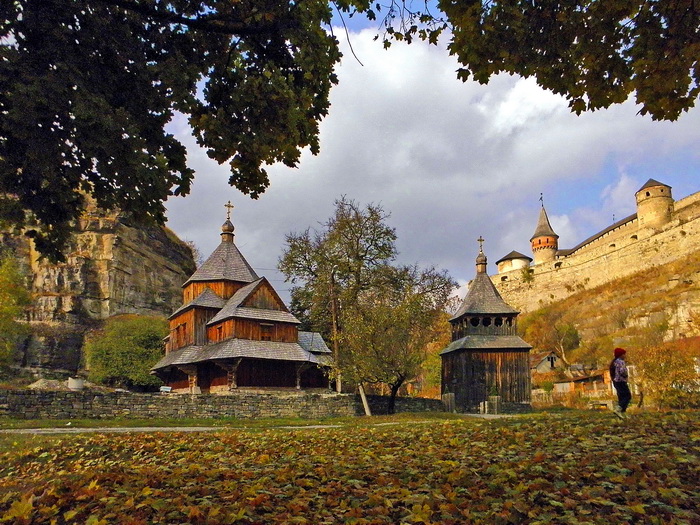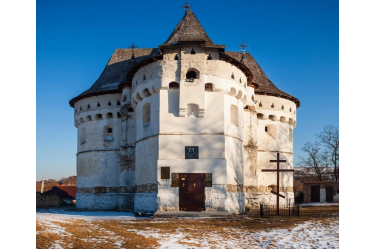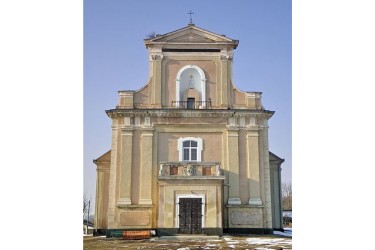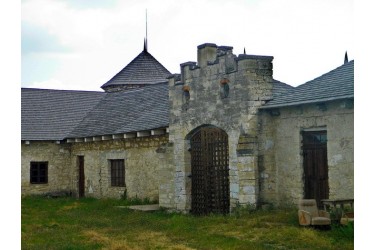A former town, and today – an ordinary village, Zinkiv lies on the steep picturesque slopes of the Ushytsia River in the Vinkovetskyi district of the Khmelnytskyi region. The first written mention is in 1404, when the Polish king Vladislav Yagailo presented Zinkiv, along with its surroundings, to the elder of Kamianets, Peter Shafranets. He also received Sataniv along with Zinkiv. In 1431, the settlement (together with Sataniv) passed to a new owner – Peter Odrovonzh from Sprova, who during the 30s of the 15th century built a defensive castle on the left eastern slope of the Ushytsia valley.

The fortress was erected from large blocks of local sandstone and limestone on the site of an old (possibly wooden) fortification of the 13-14th centuries. It occupies the western end of a very narrow promontory, bounded from the north and south by short but deep ravines. The castle had three towers, on which the coats of arms of the owners could be seen even until the middle of the 19th century. The natural protection from the side of the river was its deep valley, and from the other sides the castle was protected by a deep moat through which drawbridges led in two castle gates.

Since the second half of the 15th century Andriy Odrovonzh was the owner of the castle. In 1452 Zinkiv received the Magdeburg Law, which was confirmed by the Polish king Sigismund Augustus in 1522, allowing two fairs a year and auctions on Mondays. The town was the center of the district and played a very significant role in the defense of the Podillia estates of the Polish gentry during the 15-16 centuries.

Since the city was on the so-called Black Road, it was constantly attacked by the Tatars. They were defeated near Terebovlia by the elder of Zinkiv Jan Lyaszcz in 1453. In 1516, they were defeated at Zinkiv by Jacob Setzignevskyi. Zinkiv suffered a large-scale attack in 1524, when 12,000 Turks and Tatars burned the city, but they failed to capture the castle.

As you can see, the fortress of Zinkiv was quite reliable. This defensive capability contributed to the economic development of the city. Jews played an important role in this. In 1526, they already had their community in Zinkiv, and “Architectural Monuments of the USSR, which are under state protection” date the construction of the first synagogue in Zinkiv in 1480. To this day, two heavily rebuilt Jewish synagogues have survived in the city.

In 1546, Stanislav, the last of the Odrowonzhs, died, and the city passed into the possession of his daughter Sophia, who was the wife of the Voinitskyi castellan Jan Tarnowski. In the second half of the 16th century, he modernized the castle fortifications. The castle became regular, triangular in plan. By the end of the century Zinkiv became one of the largest cities in Podillia. After Tarnovskyi’s death in 1591, Zinkiv passed to his daughter Catherine, the wife of Adam Geronim Senyavskyi. The Senyavskyis owned the city until the middle of the 18th century.

The life of the city throughout the 17th century was not calm. In 1617, the Tatars devastated the outskirts of the city and captured many of its inhabitants, most of whom died on the way from frost. During the War of Independence Zinkiv was destroyed by Poles and Tatars, and forced many residents to move beyond the Dnipro. In 1653, the Crimean Khan, who came to the aid of Bohdan Khmelnitskyi, had been camping under Zinkiv for two months. After the war, as of 1661, only 20 Christian houses and one Jewish house remained in the devastated city. During his travels through Podillia in 1671, Ulrich von Werdum noted in his travel diary that the town was completely devastated and recorded the presence of the ruins of two temples.

In 1672, the Turks captured Podillia. According to the Buchatskyi peace treaty, Zinkiv went over to Turkey. The Turks rebuilt the fortifications, but the following year the city was liberated by the troops of the Polish crown hetman Jan III Sobeski. After the final expulsion of the Basurmen from Podillia, the castle was restored at the beginning of the 18th century by Senyavskiy’s – the owners of the city.

After the death of the owner of Zinkiv – Adam Mikola Senyavskyi, the city passed into the ownership of his daughter Sofia and her husband, governor of province August Chartoryskyi in 1762. In 1768, the castle was one of the strongholds of the Bar Confederates, who were expelled from there by Branitskyi. In 1784, Prince Adam Chartoryskyi gave Zinkiv as a dowry to his daughter Maria, the wife of Prince Ludwik of Württemberg.

After the second partition of Poland in 1793 and the capture of Podillia by the Russian Empire, Zinkiv became an ordinary county town, and in 1796 the county town was annexed to the Letychiv county. In connection with the seizure of Moldovan lands by Russia and the transfer of borders far to the south, Zinkiv loses its strategic importance as a fortress city, and begins to fall. The last owner of Zinkiv was the Prince August of Württemberg. In 1843 he sold the castle to the state treasury.

In the second half of the 19th century the castle was used for various government and economic needs. In 1887, its buildings were sold to local peasants for building material. A significant part of the castle ruins were dismantled in 1896, arguing that they allegedly threatened to fall. Today the territory of the castle is an area inclined to the west with traces of destroyed and buried defensive structures. The ruins of the southern tower one floor in hight, the oldest part of the fortress, and 4 casemates, partially covered with earth, all that has survived from the castle fortifications.

The squat tower-donjon resembles a square with a side of about 20 meters. From a distance, it can easily be mistaken for a fortification of the Second World War. There are three deep niches on the western and eastern walls of the tower. In the north-south direction, the tower is whitewashed by a wall into two rooms 4.6 and 6.4 meters wide. In the walls, are 2.6 – 3.6 meters thick, the loopholes with expansion outward from 17 to 80 centimeters are located.


The donjon-tower is adjoined by casemates, which stretch along the western defensive wall for 36 meters. These are rectangular rooms of the same type measuring 7.4 by 5.3 meters. The thickness of the transverse walls of the casemates is 1.4 meters. The casemates are partially accessible for exploration through numerous openings on the surface.

In the 1450s Andriy Odrovonzh built the wooden Trinity Church under the castle hill. In the first half of the 17th century, the old wooden church was replaced by a stone one, which also served a defensive function. The temple was repeatedly destroyed by the Tatars, it was probably destroyed by the Cossacks during the Khmelnytskyi Uprising and the Turks during the occupation of Podillia at the end of the 17th century.

The church was restored in 1708 by the owner of Zinkov, Adam Mykola Seniavskyi. The next renovation of the temple took place around 1750. In 1938, the shrine was actually destroyed by the communists, but believers still came to the ruins of the temple to pray. Only the walls remained after the destruction of the church by the soviets. All ceilings were lost, with the exception of the second tier of the bell tower. A section of the western part of the nave wall was also destroyed.

The ruins of the church were returned to believers in 1989, after which the temple began to be restored through the efforts of the Roman Catholic community. On August 24, 1990, the church was consecrated by Bishop Jan Olshanskyi. During 1994 – 1997 the temple was completely restored, and as a result it acquired a strictly ascetic appearance. The church is an example of a one-nave church with a bell tower above the main facade. Today Church of Zinkiv is one of the most important centers of Catholicism in the Khmelnytskyi region.

Chapel near the church:

In the center of the village, not far from the church and the ruins of the castle, there is a manor house from the middle of the 19th century, where the village school is located. An alley leads to the small palace from the road, the sides of which are planted with pine trees.

The palace was built in 1852 in the classicism style. It is difficult to say to whom it belonged, because back in 1843 the last owner of Zinkiv, August of Württemberg, sold the city to the treasury. The building is L-shaped in plan, has a mixed suite-corridor layout and beamed ceilings.

The front facade of the palace is decorated with a four-column portico of the Tuscan order.

An eight-column portico of the Tuscan order serves as a transition to the side facade.

The manor house is crowned with a cornice with a dentil.

In the center of the town there are several interesting old houses:



To see another interesting attraction of the village – the wooden St. Michael’s Church, you have to walk about three kilometers, descending into the valley of Ushytsia river and climbing the hill again on the opposite bank of the river. Along the way we will meet another village church – the Church of the Ascension, built at the time of independence on the site of the old church in 1730.

Along the way we will see beautiful landscapes. You will see a castle with a church and a wooden church.


St. Michael’s Church was built in 1769 in the suburbs of Kryvuli and is a fine example of Podillia wooden architecture. There are actually no such temples left in Podillia. And the latest restoration is a great example of how to restore wooden temples.

According to folklore, the funds for the construction of the church were collected by former cossacks who settled in Zinkov and their descendants. Therefore, the people still call it The Cossack. An interesting fact was recorded in the History of Churches and Parishes of Podillia by the researcher and local historian Yuhym Sitsynskyi: in 1898 as many as 1262 Orthodox were assigned to this parish. You can imagine what was happening in the church and in the yard during the big church holidays!

After several atheistic encroachments of the Soviet era, thanks to the persistence of the local elite, the church was taken under state protection as an outstanding monument of wooden architecture of Ukraine. The temple was covered with tin, which slightly spoiled its appearance. During the last restoration in 2007, the tin was replaced with natural shingles for the temple.

The church stands on a stone foundation and is three-story. It is crowned by three tops, each of which has one bend.

Each of the three branches of the temple is an octagonal room. In the middle of the church there are choirs above the entrance, and in the altar part there is a flat ceiling covering the dome. Unfortunately, the young abbot of the church, who for some reason spoke Russian in principle (and this is in the west of Ukraine), did not allow to take pictures inside the church.


Probably, once there was calvary:

A house near the church:

Holy spring on the way to the temple:

While talking about Zinkiv we can add that it is the center of folk pottery, the birthplace of the TV announcer of the 1 + 1 channel, Alla Mazur, and the place of production of delicious Zinkiv sausage.

My second visit to Zinkiv was in the spring of 2018.












